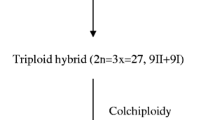Summary
1. Aneuploidy occurs rarely in roses: about a hundred instances have been recorded since 1920. All reports are on cultivated (mostly hybrid) seedlings: none has so far been found in the wild.
2. Chromosome variation in progenies is always associated with phenotypic variation, but it is not possible to determine which changes are due to loss or gain of chromosomes and which to genetical segregation.
3. The aneuploids show no tendency to revert to euploids in the germ line, and in the one case tested even breed true for their somatic number.
4. Nearly all reports of aneuploidy belong to species of the one Section Caninae, which is characterised by heterogametic reproduction in which only half to one-third of the chromosomes pair, the remainder staying as univalents. But until some means can be found of identifying individual chromosomes, there is not enough evidence to support the view that the same chromosomes always pair and that the remainder are therefore relatively inert genetically and more expendable.
5. In straight competition with euploids, the aneuploids are not necessarily weaker, shorter lived or less fit. In one family only were aneuploids found that were obviously subnormal, and these had a maximum deficiency of 2 to 4 chromosomes. Thus neither competition between cells nor competition between whole plants would be expected to eliminate aneuploids in nature. There was, however, as expected, a clear indication of reduced fertility with chromosome loss.
6. The failure to discover aneuploids in the wild in the past has been fortuitous and due to the preference for cultivated plants as a convenient source of material.
Similar content being viewed by others
Select List of References
Erlanson, E. W., 1929. Cytological conditions and evidence for hybridity in North American wild roses.Bot. Gaz.,57, 443–506.
-- 1930. The occurrence and cytology of triploid, aneuploid and partially sterile individuals among roses in the Section Cinnamomeae.Proc. 5 int. Bot. Congr., Cambridge. pp. 223–224.
—— 1933. Chromosome pairing, structural hybridity and fragments in Rosa.Bot. Gaz.,94, 551–566.
—— 1934. Experimental Data for a revision of the North American wild roses.Bot. Gaz.,96, 197–259.
Gustafsson, A., 1944. The constitution of the Rosa Canina complex.Hereditas,30, 405–428.
Harrison, J. W. H., 1955. Durham wild roses.Proc. Bot. Soc. Brit. Is.,3, 369–371; 373–374.
Hull, J. W. &Britton, D. M., 1958. Development of colchicine-induced and natural polyploid brceding lines in the genusRubus (Tourn.) L.,Univ. Maryland Agric. Exp. Stn. Bull., A-91, pp. 1–63.
Raby J., 1937. The cytology of rose stocks.Gard. Chron.,102, 145.
-- 1938. Rose stock investigations.Rose Ann., pp. 100–102.
Sansome, F. W.,Raby, J. &Fothergill, L., 1939. Stocks for roses.Rose Ann., pp. 3–5.
Täckholm, G., 1922. Zytologische studien über die Gattung Rosa.Acta Horti Berg.,7, 97–381.
Wolley-Dod, A. H., 1930. A revision of the British roses.J. Bot., suppl. pp. 1–111.
-- 1935. Some rose notes.Rept. Bot. Exch. Club. pp. 68–81.
Wylie, A. P., 1951.John Innes Ann. Rept., pp. 19–20.
-- 1952.John Innes Ann. Rept., pp. 31–32.
-- 1954. Chromosomes of garden roscs.Amer. Resc Ann., pp. 36–66.
Author information
Authors and Affiliations
Rights and permissions
About this article
Cite this article
Rowley, G. Aneuploidy in the genus Rosa. J Genet 57, 253–268 (1960). https://doi.org/10.1007/BF02987232
Received:
Issue Date:
DOI: https://doi.org/10.1007/BF02987232




